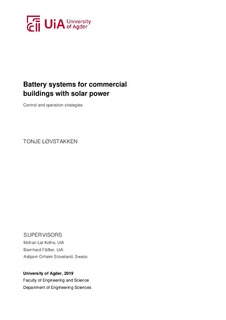| dc.contributor.author | Løvstakken, Tonje | |
| dc.date.accessioned | 2019-09-19T09:54:48Z | |
| dc.date.available | 2019-09-19T09:54:48Z | |
| dc.date.issued | 2019 | |
| dc.identifier.uri | http://hdl.handle.net/11250/2617616 | |
| dc.description | Master's thesis Renewable Energy ENE500 - University of Agder 2019 | nb_NO |
| dc.description.abstract | In order to reach the climate targets, a sustainable energy system based on renewable energy generationis required. Battery storage systems are considered part of the solution, aselectricity generationfrom renewable energy sources suchas wind and solardoes not match the energy consumption at all times.This thesis investigates control and operation of battery storage systems for commercial buildings with and without photovoltaicinstallations. It was found in the literaturereviewthat the correct size of a battery system is importantin order to have an optimal storage solution and avoid unnecessary costs. Therefore,a photovoltaicinstallationand batterystoragesystem is simulated in theHybrid Optimisation Model for Electrical Renewable(HOMER)Pro software.The power consumptionuser patternin a commercial building is also studied.Further, the operationof a battery storage system is optimised using integer linear programming in MATLAB. The battery storage system was optimised in regard today-aheadelectricity spot prices and power consumptionof a commercial building.The net present cost of different systemcombinations is calculatedwith the HOMERsoftware, and it was found that larger photovoltaicsystems without battery storage was the more profitable solution.The optimisation based on the day-ahead spotprices was able to reduce costsbased on energy fees, althoughit also increased the peaks in power consumption. This was due to low prices coinciding with hours ofhigh power consumption, which in turn can increase the fees for power consumption.For the power consumptiondriven optimisation,the peaks arereduced during high demand periodsand increased during low demand periods, thus balancing the power consumptionof thecommercial building.However,this does not reducecosts in terms of energy feesbut power fees, and the profit is dependenton which fees that apply. The goal of installing a battery storage system shouldthereforebe carefully evaluated so that it can be optimised with regard to the most profitable parametersfor a given system and building. | nb_NO |
| dc.language.iso | eng | nb_NO |
| dc.publisher | Universitetet i Agder ; University of Agder | nb_NO |
| dc.rights | Attribution-NonCommercial-NoDerivatives 4.0 Internasjonal | * |
| dc.rights.uri | http://creativecommons.org/licenses/by-nc-nd/4.0/deed.no | * |
| dc.subject | ENE500 | nb_NO |
| dc.title | Battery systems for commercial buildings with solar power : Control and operation strategies | nb_NO |
| dc.type | Master thesis | nb_NO |
| dc.subject.nsi | VDP::Teknologi: 500::Elektrotekniske fag: 540 | nb_NO |
| dc.source.pagenumber | 94 p. | nb_NO |

